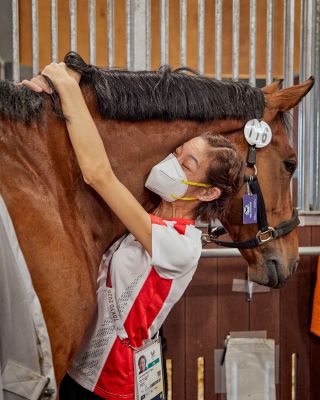Laurentia Tan (SGP) (FEI/Liz Gregg)
The unique bond between a horse and human, as well as the refined communication between the two, are important factors for success in elite equestrian sports. But what does this mean exactly for Para Dressage athletes competing at the Tokyo 2020 Paralympic Games?
While able-bodied Dressage athletes use a combination of hand, leg, and weight signals to communicate with their horses, some Para Dressage athletes require the use of compensating aids to make up for the physical or sensory limitation resulting from their disabilities.
“Walking the way that I do is normal for me and so when I learned to ride, I also learnt in a way that was normal for me,” said five time Paralympic gold medallist Natasha Baker (GBR).
“As I have minimal feeling from my hips down, my legs just hang when I’m on a horse, and they naturally follow the movement of the horse. When you see my legs moving, that’s not me. It’s a completely involuntary movement.
“This is the reason why I have to train my horses to different aids and am reliant on my voice. I train my horses to the smallest of noises or words so they know exactly what I’m asking. It can be a simple sound so they know that I want to go more forward or a command like ‘trot’ under my voice, and they know exactly what I mean.”
While there is a broad range of movement that is standard for able-bodied Dressage athletes, Para Equestrians have to find and develop their own style of communication with their horse in order to compensate for their unique disabilities.
Where necessary, athletes are allowed to use a variety of special equipment and aids which include specially designed saddles that assist the athlete with balance and support. Also permitted are the use of elastic bands to keep feet in stirrups, whips in each hand, and adapted reins.
In the case of Laurentia Tan from Singapore, who developed cerebral palsy and profound deafness after birth, she relies on people to tell her when the music begins and ends and has a greater dependency on feeling in order to communicate with her horse.
“I can ride different horses, but I must have my own customised looped reins, which are important partly because they are customised to the way I hold them,” Tan explained.
“But the reins, which are the connection between my hands and the horse’s mouth, are like a telephone line which make my conversation with my horse soft, steady, and ‘elastic.’ This contact is different depending on the horse I ride and is absolutely essential for me to bring out their best performance.
“I am also sensitive to the feeling through my seat, which facilitates the conversation between me and my horse. I can execute a good square halt through my seat. I can feel when my horse does a perfect straight square halt under me and when to give a correction if one leg is out of place.”
As other Para Dressage athletes will attest, learning to interpret their horses’ body language is one of the keys to a successful sporting relationship. But training a horse to adapt and respond to the use of compensating aids also plays an important role in the development of the horse and athlete connection.
“Before a horse is ridden by a Para Athlete, it is first trained by an able-bodied rider with classic training aids and then retrained to adapt to the athlete’s disability,” Team USA’s Head of Para Equestrian Coach Development and High Performance Michel Assouline explained.
“The horse is trained to what the person does not have. So if an athlete does not have the full use their legs, for example, the horse will be trained to receive cues and signals with a series of taps given through a compensating aid, instead of the legs. An athlete can also learn to use their voice and seat to communicate with their horse.
“For athletes who are unable to use their legs, a tap becomes like a conductor’s baton, which signals to the horse when they should move.
“An able-bodied trainer will usually begin this process and will train the horse by not using their legs, but with the tapping. So by the time the athlete takes over, the horse is already aware of what these cues represent. On average, it takes around six months to a year for the horse to be truly confident and trustworthy.”
The FEI Para Equestrian Committee was created in April 2006 to ensure that the needs and requirements of Para Equestrians are well represented in the work of the International Federation.
“As living beings with thoughts and feelings of their own, horses are extremely sensitive to the specific needs of an athlete’s disability, and are highly perceptive to verbal and non-verbal cues,” Chair of the FEI Para Equestrian Committee Amanda Bond said.
“While horses have a natural ability to adapt, and seem to have a sixth sense for knowing what is required of them, it is the compensating aids which allow Para Equestrian athletes to effectively communicate with their horses.
“The FEI Para Dressage rules have been established to ensure that athletes have the equipment they require to compete on a level playing field, while keeping competition fair and safe. These are important principles to abide by if we are to ensure the continued growth and development of Para Equestrian sport.”
Media contact:
Vanessa Martin Randin
Senior Manager, Media Relations & Communications
vanessa.randin@fei.org
+41 78 750 61 73
